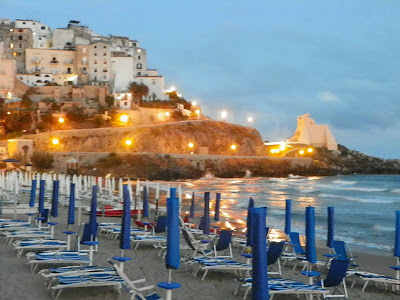 |
| view of sperlonga (55meters high) on hill surrounded by its beaches, terracina in far distance |
 |
| loved this shell wall which extended for quite a distance, was entrance way into one of the hotels |
 |
| one of the many alleys in town of sperlonga, many steps everywhere. |
 |
| The Roman Emperor Tiberius' grotto, at one end of the sperlonga beaches |
 |
| grotto and the ruins of Tiberius' fish pond (still stocked with fish) |
 |
| painted fresco walls of part of tiberius' villa |
 |
| gorgeous marble head of Ulysses, all found on site |
 |
| remains of sculpture group of Scylla, which was one of the groups displayed inside the grotto |
 |
| lovely Roman bronze helmet, fished out of the sea in 2006 |
 |
| some colorful pieces of mosaic were on display |
 |
| mosaic glass "tessere" found on-site |
 |
| small remnant of a fresco, but so very pretty of a veiled woman |
 |
| The happy Sperlonga group |
 |
| great sunsets, terracina in distance on right, circeo on far left |
 |
| Sperlonga as it was lighting up for its very lively nightlife. |
 |
| view of sperlonga from tiberius' grotto |
 |
| View from our hotel room, great sleeping with the sound of the waves |
A wonderful, relaxing weekend in Sperlonga (thanks to the invitation from our veteran sperlonga friends), halfway between Rome and Naples. Sperlonga has ancient origins, and was an area enjoyed by the Romans. It is most famous for being the site of the Grotto of Tiberius. (You can't even go to the beach and escape Roman ruins). The site was excavated in the late 50's, early 60's and there are some interesting photos of this in the Grotto's museum. The small museum houses wonderful treasures discovered on site, including mosaics, pieces of frescoes, statues and many gorgeous marble pieces which were originally located in the grotto. The most famous piece being the Gruppo di Scilla ( Struggle with Scylla). Scilla has the body of an eel and bust of a woman. She is shown killing 6 of Odysseus' men with her dog like features. Also displayed are parts of the huge statuary of Ulysses in his struggle with Polyphemus, all stories from Homer's Odyssey. There is still debate as to whether these marble groups were done by Greek or Roman artists. Regardless of who did them, they are well worth looking at in the beautiful setting in which they were originally placed in the 1st century- 2nd century B.C.




















the shell wall is so pretty :)
ReplyDelete